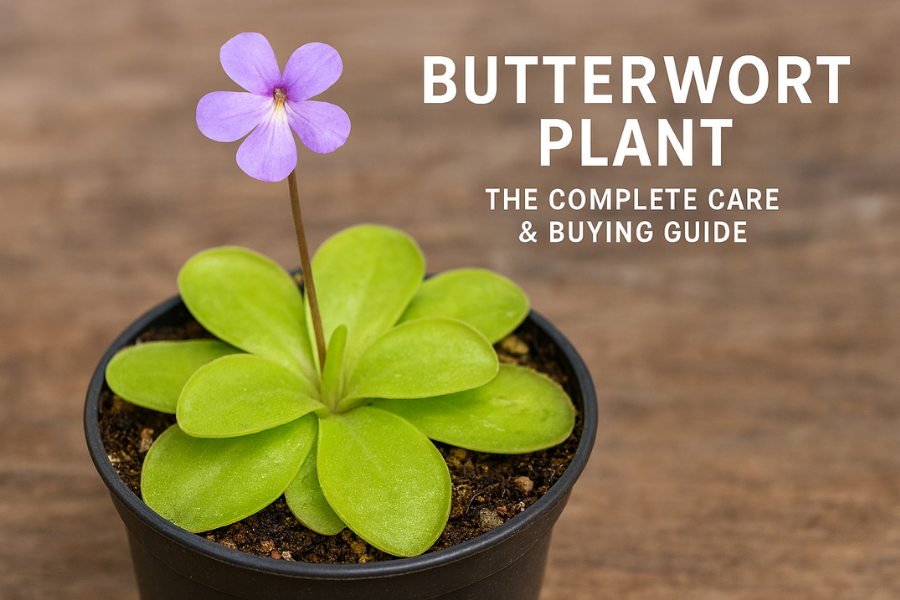The Butterwort plant (Pinguicula), affectionately called a ping, is a fascinating carnivorous plant that doubles as a natural pest controller and a beautiful houseplant. With over 80 species found across North America, Central America, South America, and Europe, these plants are prized for their sticky, dew-covered leaves that trap fungus gnats, fruit flies, and other tiny insects.
Whether you’re searching for Butterwort plant care tips, looking for a Butterwort plant for sale, or simply wondering “Do butterworts eat flies?” — this guide covers everything you need to know.
What is a Butterwort plant?
The Butterwort plant has the scientific name Pinguicula. You will find over 80 species across North America, Central America, South America, and Europe. The plant forms small rosettes of sticky leaves that lure and trap tiny insects. You can use a Butterwort as a natural pest controller and an ornamental houseplant. Do you want a compact plant that controls fungus gnats?
Can you grow Butterworts indoors?
Yes, you can grow Butterworts indoors. Many Mexican Pinguicula species adapt well to household light and temperature. You can place them on sunny east or west windowsills or under LED grow lights. Do you keep other houseplants that attract gnats?
How much light does a Butterwort need?
Provide at least three hours of direct sunlight each day. You can use 12 hours under LED grow lights as an alternative. Bright, indirect light suits outdoor placement. Higher light often turns leaves pink or purple. Do you prefer colorful leaves or greener foliage?
What potting mix should you use?
Use a low-nutrient, well-draining mix. Mix equal parts peat moss, perlite, and coarse sand for many species. Add limestone sand or crushed oyster shell for Mexican species to add slight alkalinity. Avoid regular potting soil that holds nutrients. Do you want a ready-made carnivore mix or a DIY blend?
How should you water a Butterwort?
Use distilled, rain, or reverse-osmosis water only. Place the pot in 1/2 to 1 inch of water and let the soil absorb moisture. Allow the top layer to dry slightly before you refill the tray. Reduce water when plants form succulent leaves during winter dormancy. Do you have access to collected rainwater or RO water?
What temperature and humidity do Butterworts prefer?

Mexican species prefer warm household temperatures around 65–80°F (18–27°C). Warm temperate species prefer humid, boggy conditions. Cold temperate species require a winter cold period for dormancy. You can keep humidity moderate if you keep roots moist. Which climate type matches your home?
Do Butterworts flower and what do flowers look like?
Many species bloom once or twice a year. Flowers appear in shades of purple, pink, yellow, or white. Pinguicula laueana and Pinguicula moranensis show popular, showy blooms. Do you want a plant for flowers as well as pest control?
How do Butterworts capture and digest prey?
Sticky leaf glands secrete mucilage to trap tiny insects. Digestive enzymes break down prey and allow the plant to absorb nutrients. Common prey include fungus gnats, fruit flies, mites, and springtails. Do you struggle with small flying pests around houseplants?
Are Butterworts safe for pets?
Butterworts pose no known toxicity to cats and dogs. You can place plants in homes with pets without fear of poisoning. Do you need low-risk plants around pets?
How do you propagate Butterworts?
You can propagate by leaf pullings for many species. You can divide rosettes when the plant naturally splits. You can grow plants from seed, but expect slow and variable results. Which propagation method do you plan to try first?
Where can you buy a Butterwort plant?
Search local nurseries for availability. Look for specialty carnivorous plant shops online for a wider selection. Find seeds and starter plants on major marketplaces and specialist sellers. Do you prefer a mature plant or a starter kit?
Quick checklist before you buy
- Choose species that match your home climate.
- Confirmed the water source is low-mineral.
- Pick a low-nutrient potting mix or buy a carnivore mix.
- Ask the seller about recent dormancy history.
- Check for pests on the plant before you bring it home.
Do you want a short shopping list for beginners?
What is a Butterwort plant and why does it matter for you?
The Butterwort plant has the scientific name Pinguicula. Over 80 species exist across North America, Central America, South America, and Europe. Leaves secrete sticky mucilage that acts like flypaper and attracts tiny insects. You can use a Butterwort as a natural pest controller and a decorative houseplant. Do you want a compact plant that reduces fungus gnats?
Can Butterworts live indoors and which species suit home conditions?
Yes, many species adapt to indoor life. Mexican species prefer warm household temperatures of 65–80°F (18–27°C). Warm temperate species prefer higher humidity and boggy soil. Cold temperate species need a winter cold period for dormancy. Do you have a warm room or a cool windowsill?
Do Butterworts eat flies and what do they actually capture?
Butterworts capture fungus gnats, fruit flies, mites, and springtails. Sticky leaves trap tiny insects and digestive enzymes break prey down for nutrient uptake. Do you need a plant to reduce flying pests near your other houseplants?
How should you set light, water, and soil for top Butterwort plant care?
Light: Give at least 3 hours of direct sun daily or 12 hours under LED grow lights. Soil: Use a low-nutrient mix such as equal parts peat moss, perlite, and coarse sand; add limestone sand for Mexican species. Water: Use distilled, rain, or RO water only and avoid tap water. Method: Place the pot in 1/2–1 inch of water and let the soil absorb moisture; allow the surface to dry slightly before refilling the tray. Temperature: Keep most indoor species at 65–80°F (18–27°C). Do you want a ready-made carnivore mix or a DIY blend?
How do you control gnats using a Butterwort plant for gnats?
Place the plant near infested pots where adult gnats emerge. One healthy Butterwort will reduce gnat numbers within weeks in many homes. Use several plants for larger infestations or for multiple planter clusters. Do you prefer passive control or active monitoring of pest counts?
Are Butterwort plants safe for cats and pets?

Yes, Butterwort plants have no known toxicity to cats and dogs. You can place the plant where pets roam without fear of poisoning. Do you need a pet-safe pest control solution in your living room?
How do you propagate and maintain Butterwort plant health?
Propagate via leaf pullings, division of rosettes, or seed for long-term projects. Expect faster results from leaf pullings and division. Adjust watering when the plant forms succulent winter leaves and reduce water during dormancy. Do you plan to propagate now or buy an established rosette?
Where can you buy Butterwort plants, seeds, and supplies near you or online?
Search local nurseries for “Butterwort plant near me” to find nearby sellers. Find starter plants, seeds, and mixes on Amazon and specialist carnivorous plant shops. Many online sellers ship seeds labeled as Butterwort plant seeds and offer species lists. Do you prefer online convenience or local pickup?
How to choose the right Butterwort plant for Amazon purchases and seed orders?
Match the species to your climate and light level. Pick Mexican Pinguicula for warm indoor rooms. Choose temperate species only if you can provide a winter cool period. Read seller photos and plant descriptions carefully before you buy. Do you want help picking a species on Amazon?
Quick starter checklist and FAQ for common search queries
- Butterwort plant care: Low-nutrient soil; distilled water; bright light; 65–80°F.
- Butterwort plant for gnats: Place near infested pots; use multiple plants for heavy infestations.
- Butterwort plant eating: Target prey include fungus gnats, fruit flies, mites, springtails.
- Butterwort plant safe for cats: Non-toxic to cats and dogs.
- Butterwort plant Amazon: Find seeds, starter plants, and mixes on major marketplaces.
- Butterwort plant seeds: Sow on low-nutrient mix; expect slow germination.
- Butterwort plant near me: Check local specialty nurseries and carnivore forums.
- Can butterworts live indoors?: Yes, many species adapt to indoor light and temperature.
- Do butterworts eat flies?: Yes, they trap small flies and gnats with sticky leaves.
FAQs
What does a Butterwort eat?
Butterworts trap fungus gnats, fruit flies, mites, and springtails using sticky leaf glands. Digestive enzymes release nutrients the plant absorbs.
Do Butterworts eat flies?
Yes. Butterworts capture small flies and gnats that land on their leaves.
Can Butterworts live indoors?
Yes. Many Mexican Pinguicula species thrive indoors at 65–80°F (18–27°C) with bright light or LED grow lights.
How do I water a Butterwort?
Use distilled, rain, or RO water only. Place the pot in 1/2–1 inch of water and let the soil absorb moisture. Allow the surface to dry slightly before you refill the tray.
What potting mix should I use?
Use a low-nutrient mix such as equal parts peat moss, perlite, and coarse sand. Add limestone sand or crushed oyster shell for Mexican species to raise alkalinity slightly.
Are Butterwort plants safe for cats?
Yes. Butterworts have no known toxicity to cats and dogs. You can keep them in homes with pets.
Can a Butterwort control gnats?
Yes. A healthy Butterwort near infested pots will reduce fungus gnat numbers quickly. Use several plants for larger infestations.
Where can I buy Butterwort plants or seeds?
Search local nurseries for “Butterwort plant near me.” Find seeds and starter plants on Amazon and specialty carnivorous-plant shops online.
How do I propagate a Butterwort?
Use leaf pullings for fast results. Divide rosettes when the plant naturally splits. Expect slow and variable results from seeds.
How much light do Butterworts need?
Give at least three hours of direct sun or 12 hours under LED grow lights. Bright indirect light suits outdoor placement.
Final Thoughts
Butterworts provide reliable pest control and add visual charm to your home. You will get the best results when you match species to your room light and temperature. You will protect plant health by using low-mineral water and a low-nutrient potting mix. You will speed pest reduction by placing plants close to infested pots and by using several plants for large problem areas. You will enjoy blooms from many species when you keep light levels high and follow seasonal care. Want a simple starter checklist or a 7-day care plan next?
“Your QuickFast-track to lifestyle, tech & business insights.”



